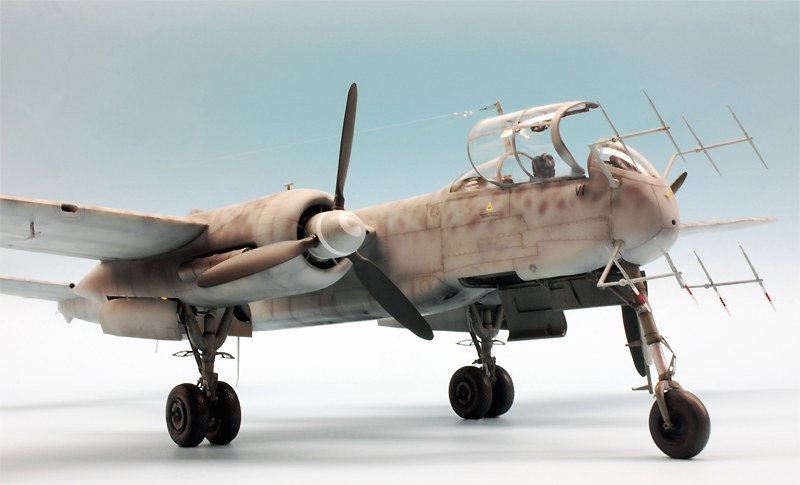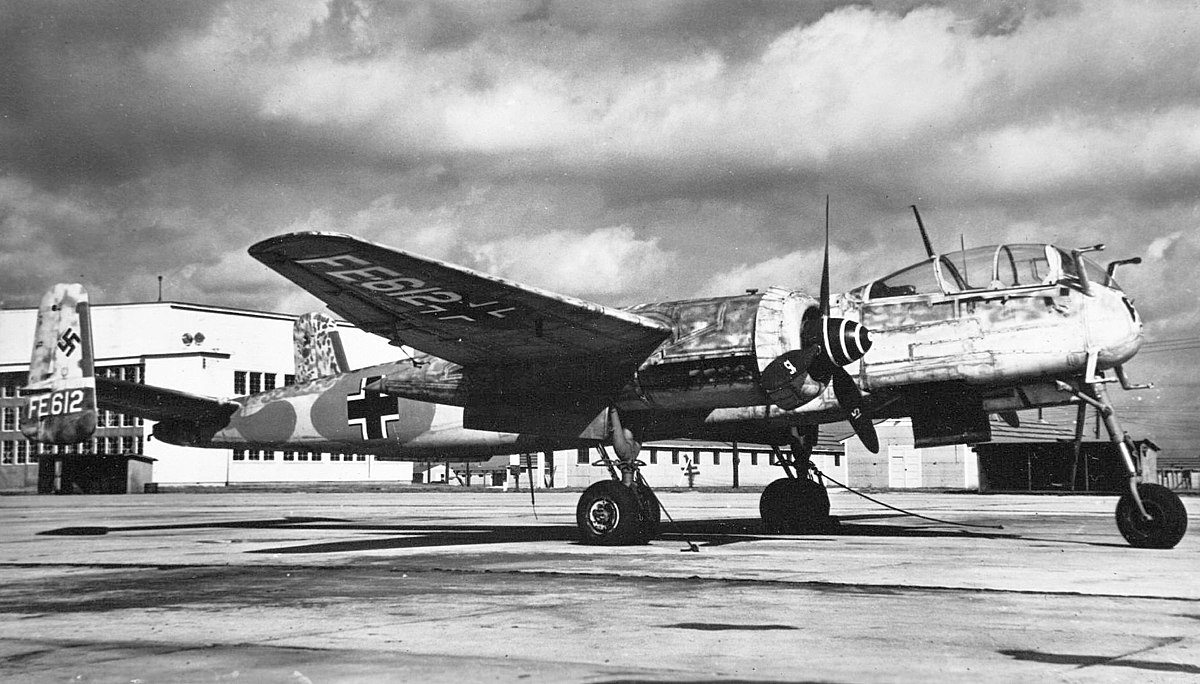

The Heinkel He 219 was a twin-engine night fighter used by the Luftwaffe in the later stages of World War II.
History
Development
Design work on the He 219 began in the early 1940s and was begun by Robert Lusser, an engineer at Heinkel, who developed the He 219 from a private venture design intended to provide a single aircraft type capable of fulfilling a number of roles, from torpedo attack to long range air fighting. The type’s many innovative features led to the design being rejected by the RLM in 1940. However, a chance visit by Generalmajor JosefKammhuber, head of the Luftwaffe’s night fighter branch, resulted in the private venture design being reworked for the night fighter role, with the designation He 219, in the face of serious and determined opposition.
The excellence of Heinkel’s design meant that only minor modifications to the first prototype were required before it’s first flight on 15th November 1942. The type’s susceptibility to yaw/roll instability was cured by extension of the rear fuselage, and enlargement of the tail surfaces. The subsequent armament and equipment alterations prompted the RLM to request reduction in the 29 resulting armament variations. Development was also delayed by Allied air raids during march and April 1942, which virtually destroyed all production facilities for the He 219 at Rostock, and resulted is production being dispersed to a number of different sites.
The second, third and forth prototypes joined the development programme in March 1943, by which time the initial order for 100 examples had been increased to 300.. The 219 V2 and V3 carried six MG151/20 cannon – one in each wing root and four in a ventral tray, with V3 having larger tail surfaces. The 219 V4 was fitted with FuG 202 Lichtenstein airborne interception radar. These were supplemented by a further six prototypes, used for operational trials as He 219A-0s. These were He 219A-0/R1s with four 30 mm MK108s and two 20 mm MG151/20s, or He 219A-0/R2s with four 30 mm MK103s and two MG151/20s
Service
The type made its operational debut on the night of 11th-12th June 1943, when Major Werner Streib, Gruppenkommandeur of 1 Gruppe of Nachtjagdgeschwader 1 based at Venlo in the Netherlands, used a pre production He 219A-0/R2 for a live interception mission. Assisted by his radar observer, Unteroffizier Fischer, Streib allegedly destroyed five RAF bombers, only for the aircraft to break up on landing, due to a high speed landing resulting from flap failure. Fortunately Streib and Fischer were unharmed and, during six sorties flown over the next ten days, Streib’s unit destroyed an additional 20 RAF aircraft.
Variants
The He 219 A-0 was initially used for pre-production aircraft but it became the first major production version with 1,750 PS DB 603A engine. 104 He 219 A-0 were built as of 30 November 1944. He 219 A-1 was a proposed reconnaissance-bomber aircraft, however its construction was abandoned. He 219 A-2 was similar to the He 219 A-0 but with extended engine nacelles with additional fuel tanks and 1,670 PS DB 603AA engines. 85 He 219 A-2 were built as of 30 November 1944. He 219 A-5 was a planned three-seat night fighter, however only some of its prototypes were known to have been built from A-2 airframes. He 219 A-6 was a planned de Havilland Mosquito-hunter. It was a stripped-down version of the He 219 A-2, that was armed with four 20 mm MG 151/20s. He 219 A-7 was an improved night fighter version, that was powered by two 1,800 PS DB 603E engines. 210 He 219 A-7 were ordered as of 30 November 1944. He 219 D-1 was mainly the He 219 A-7 airframes which were adapted for Jumo 213E engines. Only five He 219 D-1s were known to be delivered in 1945.
Specifications
Heinkel He 2I9A-7/Rl Uhu
Type: night-fighter
Accommodation: pilot and radar operator in tandem on ejection seats in an enclosed cockpit
Equipment: standard communication and navigation equipment, plus a Revi I6/B reflector gun sight, FuG 2l2 Lichtenstein airborne interception radar, FuG 220 Lichtenstein SN-2 airborne interception radar, and FuG 2l8 Neptun tail warning radar
Powerplant: two Daimler-Benz DB 603G inverted-Vee piston engines each rated at 1,4l7kW (l900hp) for take-off and 1,l63kW (|560hp) at 7375m (24,200ft)Fuel: internal fuel 2700 litres (593.9lmp gal; l3.25US gal); external fuel none
Weights: empty I l,200kg (24,692lb); maximum take-off l5,300kg (33,730lb)
Maximum speed: 670km/h (4l6mph) at 7000m (22,965ft)
Cruising speed: maximum 630km/h (39lmph) at optimum altitude and economical 540km/h (335.5mph) at optimum altitude
Initial climb rate: 552m (l8l0ft) per minute
Service ceiling: l2,700m (4l,665ft)
Maximum range: 2000km (I243 miles);
Typical range: l545km (960 miles)
Wing span: l8.50m (60ft 8.35in)
Wing area: 44.50sq m (478.99sq ft)
Length: lS.54m (50ft l l.8lin)
Height: 4. l0m (l3ft 5.4in)
Fixed armament: two 30mm MK 108 fixed forward-firing cannon with 100 rounds per gun in the wing roots, two 30mm MK 103 and two 20mm MG 151/20 fixed forward-firing cannon with 100 and 300 rounds per gun respectively in a ventral tray, and two 30mm MK 108 cannon with 100 rounds per gun in an obliquely forward – and upward-firing installation in the upper part of the rear fuselage